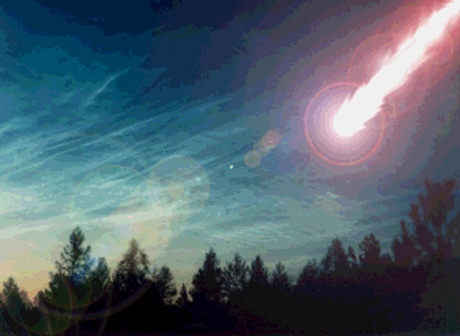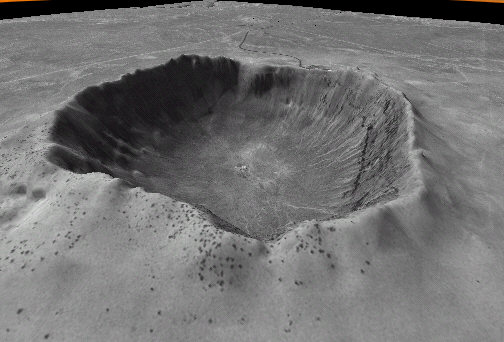The final Virtual Vista is a fitting one to illustrate the fragility of Earth's
environments. The animation and fly-by included in this Virtual Vista illustrate
the timing and effects of a relatively small impact event on Earth's surface.
The images on this page are of the Barringer Crater (also known as Meteor
Crater) near Winslow, Arizona, USA. The crater was excavated by the impact
of a small (approximately 100 m diameter) iron meteorite about 50,000 years
ago.
 <a onClick="window.open('/olcweb/cgi/pluginpop.cgi?it=jpg::::/sites/dl/free/0077373731/90804/MeteorCrater01.jpg','popWin', 'width=357,height=282,resizable,scrollbars');" href="#"><img valign="absmiddle" height="16" width="16" border="0" src="/olcweb/styles/shared/linkicons/image.gif"> (113.0K)</a>
<a onClick="window.open('/olcweb/cgi/pluginpop.cgi?it=jpg::::/sites/dl/free/0077373731/90804/MeteorCrater01.jpg','popWin', 'width=357,height=282,resizable,scrollbars');" href="#"><img valign="absmiddle" height="16" width="16" border="0" src="/olcweb/styles/shared/linkicons/image.gif"> (113.0K)</a>
At the time of the impact event, Arizona's climate and ecology were quite
different than they are today. North America was in the midst of a glacial
stage, and Arizona's climate was cooler and wetter than now. Rather than desert
scrub, much of the area was colonized by coniferous forest. Following the
impact event, the forest and most other living organisms were destroyed for
several tens of kilometers outward from "ground zero".
 <a onClick="window.open('/olcweb/cgi/pluginpop.cgi?it=jpg::Meteor Crater view looking north::/sites/dl/free/0077373731/90804/MeteorCrater02.jpg','popWin', 'width=462,height=344,resizable,scrollbars');" href="#"><img valign="absmiddle" height="16" width="16" border="0" src="/olcweb/styles/shared/linkicons/image.gif">Meteor Crater view looking north (40.0K)</a>Meteor Crater view looking north
<a onClick="window.open('/olcweb/cgi/pluginpop.cgi?it=jpg::Meteor Crater view looking north::/sites/dl/free/0077373731/90804/MeteorCrater02.jpg','popWin', 'width=462,height=344,resizable,scrollbars');" href="#"><img valign="absmiddle" height="16" width="16" border="0" src="/olcweb/styles/shared/linkicons/image.gif">Meteor Crater view looking north (40.0K)</a>Meteor Crater view looking north
This Virtual Vista was created by developing an animation of a simulated
meteor passing over a pine forest, then merging this animation with a fly-by
over a digital elevation model (DEM) and digital aerial image of the crater
area.
Points to Ponder:
1. How much energy do you think was liberated by this impact?
2. What is the likelihood of a similar impact occurring somewhere on Earth
during your lifetime?
Click on the link below to view the animation.
 Meteor Crater Fly-By (2398.0K)
Meteor Crater Fly-By (2398.0K)
To learn more about the Barringer Crater, visit their website by following
the hyperlink below.
Barringer Crater


